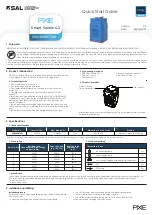
Operating instruction manual
| MS40/EX Magnetic Level Gauge Switch 3
1.0 Description
The MS40 is a magnetically activated double pole double throw switch. When the MS40 is mounted on a KM26 or an external
chamber that has a magnetic ABB float it can sense high or low levels within a vessel.
The unique magnetic coupling action eliminates the need for such things as seals, diaphragms, springs. Or torque tubes because
there is no physical contact with the process. No valves are required to block off the switch from the process to perform any main-
tenance or operational checks, and since the MS40 is isolated from the process it does not need to be cleaned.
2.0 Application
The MS40 will provide either normally open or normally closed dry contacts that can be used to activate external devices such as
alarms or solenoids. The capacity of the switch allows for a wide range of devices to be switched, as long as the stated limits are
not exceeded.
Since the MS40 is magnetically activated, it is suited for any application where it is necessary to sense the passing of a magnet or
magnetic field near it. However, its main application is to sense the passing of a magnetic float in a KM26 or similar chamber at
-
tached to a vessel containing a fluid. This will provide for the detection of a start/stop trip point of either a total or interface level in
any vessel. These trip points can be used for alarms or to activate a pump motor starter relay.
3.0 Operation
The MS40 consists of two snap action switches assembled in a double pole double throw configuration, and a precision cam/spindle
assembly which contains a rod magnet. A magnetic ABB float passing by the MS40 will cause its magnet to rotate through approxi
-
mately 60° of arc, causing the integral snap action switches to actuate. The action of the contacts is break before make.
The spindle is not totally free to rotate unless a strong magnetic field is passed parallel to the MS40 switch because the spindle
magnet is magnetically latched to one of two stops. The spindle magnet attraction for a stop is great enough to keep the spindle from
rotating on its own, but the magnetic field of a float is strong enough to cause the spindle magnet to release from the stop to which
it is attached and rotate to align itself with the float’s magnetic field. As the float passes by the MS40 switch, the spindle magnet will
latch to the opposite stop. It will remain in this position until the float passes by again.
4.0 Mounting & Installation
The standard MS40 is mounted using a stainless steel clamp that passes through the mounting slot in the housing. The clamp is
then fastened to the KM26 or similar chamber. The switch can be easily positioned by loosening the clamp and sliding the switch to
the correct position on the chamber. The switch will trip at a point 0.5” above the center of the side of the housing.
A rod mount method is also available (optional). With this mounting method, a rod is permanently attached to the KM26 with the
MS40 subsequently attached.
The following procedure outlines the steps necessary to install the switch.
Warning:
Make sure circuit is de-energized while installing the switch.
1. Mount the switch to the chamber where you want the switch to trip. The switch should be mounted 90° from the indicator as-
sembly to insure optimum magnetic coupling.
2.
Remove the cover of the MS40 (or MS40/EX) enclosure. The switch mechanism is mounted to the base of the enclosure with
its integral terminal block easily accessible. Note: The MS40/EX/B switch employs a wiring harness and the connections should
be made external to the switch enclosure.
3.
Route the field wiring through the “female NPT coupling of the MS40 (or MS40/EX) enclosure base.
4.
Connect the field wires to the terminal block according to the application. A schematic diagram can be found at the end of this
document.
5.
Make sure the field wires do not interfere with the rotation of the spindle or that they will not become pinched between the
MS40 cover and housing when the cover is installed. It is best that the field wires be as short and direct as possible from the
coupling to the terminal block.
6. Reinstall the cover on the housing being careful not to pinch the wires.
7.
The float must be cycled past the switch in both directions to insure that the switch will operate properly when put into service.
Содержание MS40/EX
Страница 5: ...Operating instruction manual MS40 EX Magnetic Level Gauge Switch 5 ...
Страница 6: ...6 MS40 EX Magnetic Level Gauge Switch Operating instruction manual ...
Страница 7: ...Operating instruction manual MS40 EX Magnetic Level Gauge Switch 7 ...
Страница 8: ...8 MS40 EX Magnetic Level Gauge Switch Operating instruction manual ...
Страница 11: ...Operating instruction manual MS40 EX Magnetic Level Gauge Switch 11 ...






























